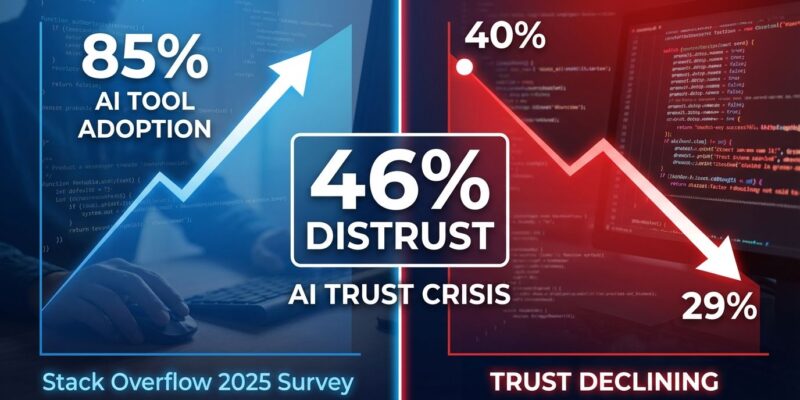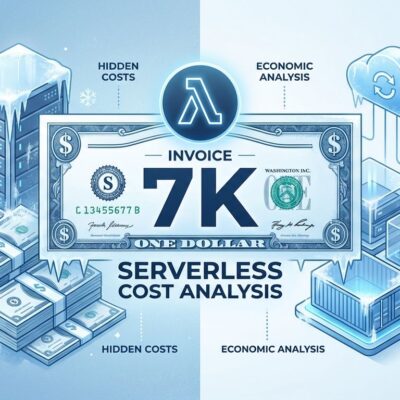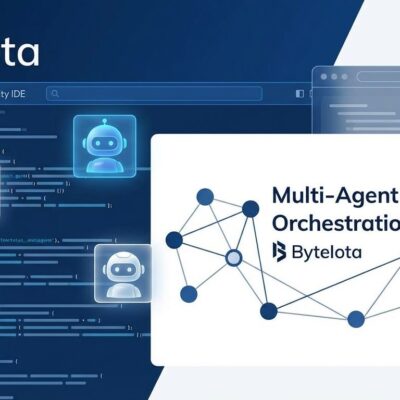
Stack Overflow’s 2025 Developer Survey dropped a number that should make AI vendors nervous: trust in AI coding accuracy fell from 40 percent to 29 percent year-over-year. Meanwhile, 46 percent of developers actively distrust AI-generated code. That’s not a marginal decline—it’s a 27 percent drop in trust while distrust now exceeds trust by 17 percentage points.
The kicker? Adoption is climbing. Eighty percent of the 49,000 surveyed developers use AI tools in their workflows. JetBrains’ 2025 survey found 85 percent adoption across 24,534 developers. Stack Overflow calls it “willing but reluctant”—developers use tools they don’t trust.
This isn’t a contradiction. It’s the AI coding revolution hitting reality.
The Trust Collapse in Data
Stack Overflow’s survey reveals a clear trend: positive sentiment toward AI tools dropped from 72 percent in 2024 to 60 percent in 2025. Trust fell harder—from 40 percent to just 29 percent. Only 3 percent of developers highly trust AI outputs. When the stakes matter, 75 percent still ask another person for help instead of trusting AI.
JetBrains paints a different picture. Their survey found that 9 in 10 developers save at least one hour weekly using AI tools, and 20 percent save eight hours or more—a full workday. Eighty-five percent use AI regularly for coding.
Both surveys are correct. They’re measuring different aspects of the same paradox. Stack Overflow asked about trust and accuracy. JetBrains measured time saved. The gap between them tells the real story: developers feel faster when typing less, but trust is eroding because the output quality doesn’t match the hype.
Why Trust Died: The “Almost Right” Tax
Forty-five percent of developers cited “AI solutions that are almost right, but not quite” as their primary frustration. This is the killer. Wrong code fails fast. “Almost right” code wastes hours in debugging. Sixty-six percent of Stack Overflow respondents spend additional time fixing flawed AI-generated code.
The perception gap is staggering. A 2025 study by METR tested experienced developers on large open-source codebases they’d contributed to for years. Using AI tools, these developers took 19 percent longer to complete tasks than without AI. They expected a 24 percent speedup. Even after experiencing the slowdown, they believed AI had made them 20 percent faster.
Security makes it worse. Veracode’s 2025 analysis of 100+ large language models across 80 coding tasks found that 45 percent of AI-generated code introduces security vulnerabilities. Java code fails 70 percent of the time. Eighty-six percent of AI code samples failed to defend against cross-site scripting. Models are getting better at coding syntax but not improving at security—a systemic issue, not a scaling problem.
Then there’s technical debt. AI-generated code includes 2.4 times more abstraction layers than human-written code. Features built with more than 60 percent AI assistance take 3.4 times longer to modify after six months. Forty percent of junior developers admit deploying code they don’t fully understand. Forrester forecasts a “technical debt tsunami” over the next two years as organizations grapple with maintaining AI-generated codebases that nobody comprehends.
The Pragmatic Paradox: Why Use Tools You Don’t Trust?
If developers don’t trust AI tools, why do 80 to 85 percent use them daily? The answer isn’t irrational—it’s pragmatic.
Sixty-eight percent of JetBrains respondents expect employers to require AI tool proficiency soon. Enterprise mandates don’t care about trust. Time pressure forces adoption. “Faster to fix than write from scratch” becomes the calculus, even when AI-generated code needs debugging.
Context matters. AI excels at boilerplate code, documentation, and common patterns it’s seen during training. It struggles with novel implementations, security-critical code, and complex business logic. Some teams report 70 percent productivity gains. Others see 20 percent losses. The difference isn’t the tools—it’s knowing when to use them.
Developers aren’t giving AI the keys. They’re using it as a typing assistant while maintaining full responsibility for output. That’s “willing but reluctant” in action: adopt the tool, verify everything it produces, and never forget that “almost right” costs more than starting from scratch.
What the Survey Comparison Reveals
Stack Overflow and JetBrains asked different questions and got different answers. Stack Overflow focused on trust, accuracy, and sentiment. JetBrains measured time savings and productivity. Both surveys agree on one thing: adoption is near-universal at 80 to 85 percent.
The divergence reveals perception versus reality. JetBrains respondents report feeling productive—typing less, exploring solutions faster. Stack Overflow respondents report spending more time debugging, questioning accuracy, and ultimately trusting humans over AI when it matters. Both are true. The time saved generating code gets spent debugging and securing it.
This is the maturation curve. Early adopters chased hype. Current users face reality. Trust dropped 11 percentage points in one year because the gap between marketing claims—10x productivity, autonomous coding agents—and actual experience—19 percent slowdowns, 45 percent vulnerability rates—became impossible to ignore.
Practical Framework: When to Use AI, When to Avoid
The surveys and research point to clear patterns.
Use AI tools for:
- Boilerplate code generation and repetitive tasks
- Documentation and code comments
- Exploring multiple solution approaches
- Standard library usage and common patterns
- Learning new frameworks (with thorough verification)
Avoid AI tools for:
- Security-critical implementations (45 percent introduce vulnerabilities)
- Novel code with no similar training examples
- Complex business logic requiring deep context
- Production code deployed without comprehensive review
- Anything you don’t fully understand (40 percent of juniors deploy code they can’t explain)
The “trust but verify” workflow works: use AI to accelerate initial implementation, treat all output as untrusted input, review every line for logic and security, test thoroughly, and refactor the 2.4x excess abstraction layers AI tends to add.
The Maturation Point
The 2025 surveys mark an inflection point. Trust is declining while adoption climbs. That’s unsustainable long-term. Either AI vendors address accuracy, security, and the “almost right” debugging tax, or trust will keep falling until adoption follows.
Sixty-eight percent of developers expect employers to mandate AI tool proficiency. That’s coming. But “AI competency” doesn’t mean blind tool usage. It means knowing when AI helps and when it hurts. It means treating AI as an assistant that accelerates typing, not a replacement that eliminates thinking.
Stack Overflow framed it perfectly: “The future of code is about trust, not just tools.” Developers are willing but reluctant. They’ll use AI pragmatically while maintaining skepticism. The gap between vendor hype and developer experience is closing. The industry is maturing from blind adoption to critical, context-aware tool usage.
That’s not a crisis. That’s progress.












